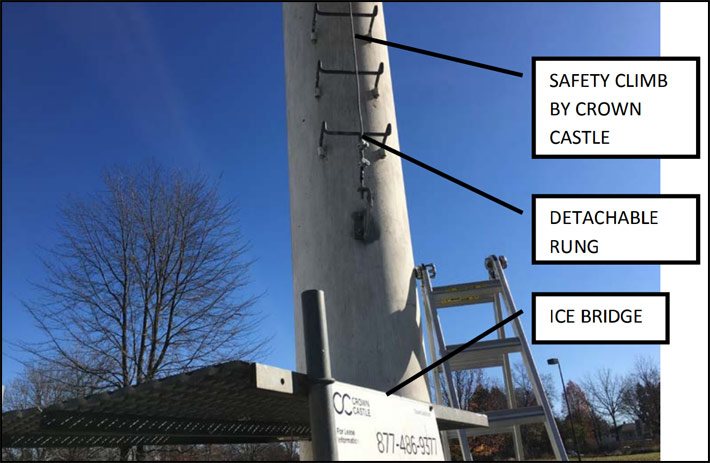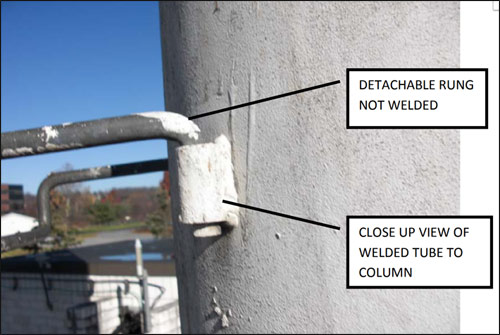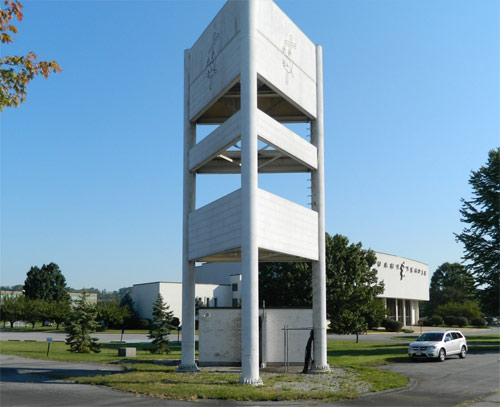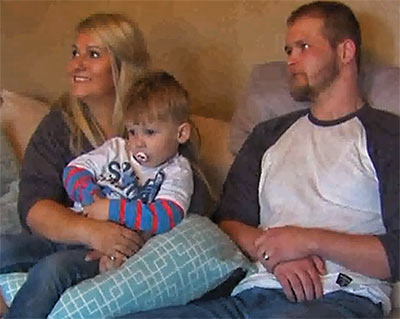
The church bell tower had removable climbing brackets without a safety climb that was added later when Crown Castle managed the tower. Photo: Robson Forensic
With a Philadelphia, Pa. jury trial scheduled to begin today to determine whether AT&T and other defendants were negligent and contributed to a tower technician falling 50 feet to the ground and causing him to sustain severe and permanent injuries, the carrier agreed to a $30 million settlement, the largest recorded payment in the U.S. to an injured wireless infrastructure worker, according to Wireless Estimator’s tracking of industry lawsuits.

Photo: Robson Forensic
The June 15, 2013 incident in Allentown Pa. left Thomas Jeglum, then 23, in a coma for months and with multiple injuries, including a permanent traumatic brain injury and numerous fractures to his pelvis, spine, arm and legs.
According to a statement from Jeglum’s law firm, Kline & Specter, PC of Philadelphia, Jeglum remains in a full-time neurorehabilitation facility in California.
Among defendants in the case were AT&T Mobility LLC and NCW PCS LLC, both direct or indirect subsidiaries of AT&T, and BTE/BT Engineering entities. The lawsuit alleged that AT&T knew of preventable hazards at the tower, specifically that there was no safety climb device and the step brackets were temporary and should not have used for access, but failed to do anything to remedy or warn of them.
According to court documents, Jeglum was employed by Jacobs Telecommunications, Inc., and on Sat., June 15, 2013, Jacobs’ tower crew members were at the Woodlawn Calvary Temple site – a bell tower – to perform a 4G installation for AT&T, the owner of the tower that was built around 1996. The design code at the time of construction was TIA/EIA-222-F.

The Calvary Temple tower was constructed and designed in 1996 using the TIA/EIA 222F standard
Earlier that morning, acting supervisor Jeremy Beaver and Travis Davies arrived at the site and began their preparation. Jacobs employees Thomas Jeglum and Dylan Walker (neither of whom had been at the Woodlawn site previously) as well as Cedric King and Scott Embres arrived later, met with Beaver to discuss the work to be performed that day.
Davies ascended the tower first and was at the top platform beginning to rig a block with the intent to haul tools and equipment and with the intention to install a temporary safety rope on the tower.
Jeglum ascended the tower next. It was later confirmed that he was using his safety harness and double hooking to the removable climbing facility rungs of the three-leg concealment tower.
Walker, King and Beaver were on the ground performing various duties. When Jeglum was near the top of the tower and near the work platform, Davies heard a loud steel crash and a loud scream. When he focused on the sound, he observed Jeglum falling to the ground.
After his fall, a steel rung from the tower climb was discovered near Jeglum at the base of the tower; the rung was not present on the ground at the time Davies and Jeglum began their ascent.
An engineers’ report from Robson Forensic said:
• The installation of a temporary safety rope (vertical lifeline) required ascension of the unsafe climbing facility by double hooking to detachable rungs.
• The climber attachment anchorage did not meet the requirements of the TIA-222-G, TIA-222-F or OSHA standards since the rungs were not welded or permanently affixed to the tube inserts that were welded to the structure.
• From our investigation on November 18, 2016, the first, bottom rung (the rung closest to the bottom) was snug, but the second rung above was loose making a visual determination of which rungs were loose or snug impossible.
• There were no warning signs posted regarding the hazard creating a concealed hazard of the removable or loose rungs, a condition of which Thomas Jeglum was unaware.
Their report also said that the first (bottom) rung of the ladder is located about 11 feet above the surrounding ground surface and the ladder itself extends another approximately 35 feet up from that point. The rungs are removable and slide into steel tube inserts. The steel tube inserts are welded to the northeast column, but the rungs are not mechanically connected to the steel tubes in any way.
They also said, “AT&T failed to properly inspect the tower at the time of acquisition and failed to correct the inherent tower deficiencies. Both the ladder rungs and the lack of a permanent safety climb rendered the Woodlawn Tower unsafe due to the preventable hazards and to the failure of AT&T to perform proper inspection and maintenance of their tower.”
The police inspected Jeglum’s safety harness and later cut it off of him prior to transporting him to the Lehigh Valley Hospital.
Had the lawsuit gone before a jury trial today, the plaintiff would have presented statements made by AT&T representatives during their depositions that there wasn’t a safety climb on the ladder, such as the below statements made by AT&T representative Jim Coleman in 2017:
Q. And regardless of whether AT&T had access to that document, we see from the document we went through with Mr. Schaffer that AT&T was aware that the Woodlawn tower had no safety climb as early as 2009, correct?
A. Yes.
Q. And, therefore, the AT&T tower was not compliant with the TIA standard that we read earlier, correct?
CONROY: Object to the form. You may answer.
THE WITNESS: If I’m reading that correctly, it doesn’t comply.
(By Mr. Trunk): It doesn’t comply, correct?
A. Correct.
Q. I wasn’t sure if you said apply or comply.
A. Comply. I’m sorry.
Following review of the deposition, Coleman said that his ‘comply’ answer should be changed to a more complete answer of: “It does not comply with TIA 222-G; however Rev G does not apply to this tower. The TIA 222 Rev F does apply and the tower does comply.”
AT&T area manager Paul Condrack’s deposition also added support for the plaintiff’s case.
When questioned whether the Woodlawn tower should have had a safety line installed on it, he pointed out that he was not a safety expert, but, “Yes. I would agree that a safety line should have been installed.”
After being asked why would he tell a jury that it should have been on the tower, if allowable, before the accident, he said, “It would have provided the opportunity to climb the tower safer if utilized by the climber.”
The plaintiff was ready to introduce to jurors that AT&T was more concerned about the cost of the safety climb than climber safety, which they believed was minimal based upon an estimation from their consultant that welding the ladder rungs would have only cost $6,500, and installing a safety climb would have been only $7,650 based upon the actual cost paid by Crown Castle, the company that assumed management responsibility from AT&T for the Woodlawn site in 2016.
What could have motivated AT&T to settle was the plaintiff’s recently amended request to add to any award punitive damages because of AT&T’s “outrageous” conduct.
AT&T was denied their partial summary judgment request to not allow punitive damages.

Thomas Jeglum with his wife, Regina, and one of their two children. He was in a coma for two months following the accident and still has serious health problems.
“The family of Tommy Jeglum and we are gratified that we were able to adequately compensate him and provide for first class care for the rest of his life,” said attorney Shanin Specter.
Jeglum’s wife, Regina, informed Wireless Estimator today that she was overjoyed upon being informed of the settlement, and she has hired a conservator to manage the funds to ensure that her husband will continue to get the best care available.
She said that Tommy is oftentimes unstable on his feet, but is accorded trips and social interaction at the rehabilitation center.
“But he lives in the moment and can’t enjoy past memories,” Regina said, troubled that he doesn’t remember the birth of his two children, now ages 5 and 7.
Regina, who has limited her social media interaction, said, “I truly want to reach out and thank everyone who has given us their love and support over these many years.”
















